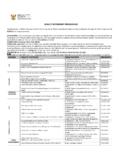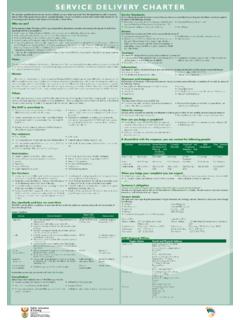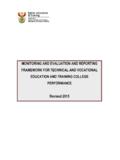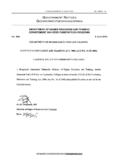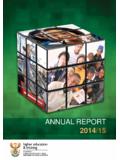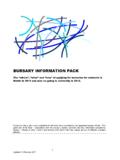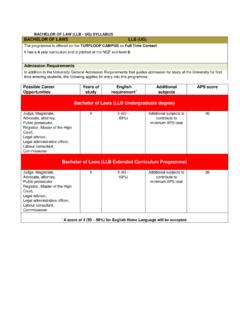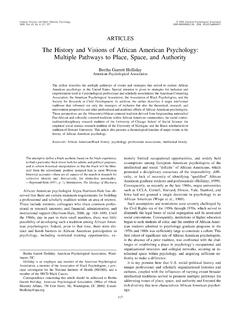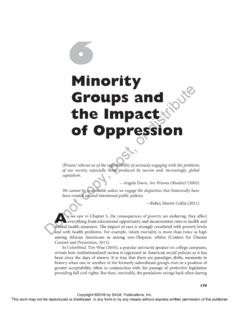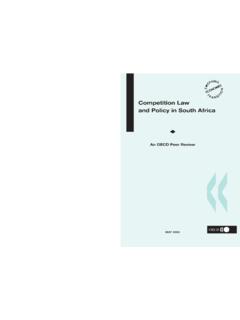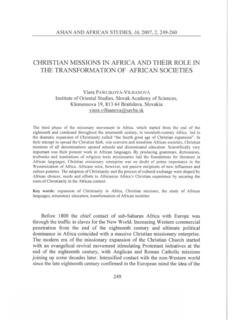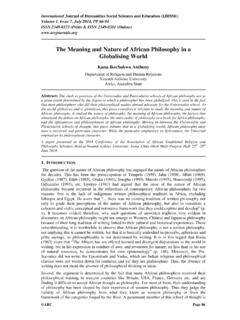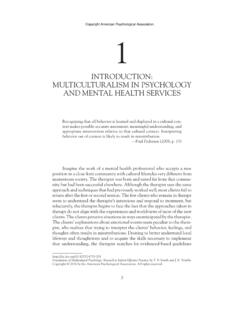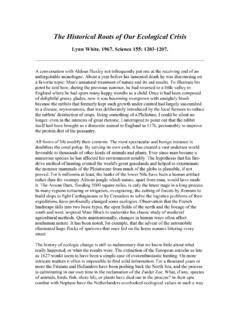Transcription of 2020 - Department of Higher Education and Training
1 The 2020 List of Occupations in High Demand: A Technical Report Labour Market Intelligence research programme2020 NSFN ational Skills FundFUNDING TO SKILL OUR NATION2020 Michele Capazario, Fouch Venter (DNA Economics)The 2020 List of Occupations in High Demand: A Technical Report Labour Market Intelligence research programmeThE 2020 LisT oF oCCupATioNs iN high DEMAND: A TEChNiCAL REpoRT AcknowledgementsThe authors would like to thank everyone who assisted with and contributed to the creation of the List of occupations in high Demand for 2020. We extend our gratitude to the Department of Higher Education and Training (DhET) and the Development policy Research unit (DpRu) for their guidance and input throughout the process. in particular, the contributions of Ms Mamphokhu Khuluvhe (DhET), Ms sybil Chabane (DhET), Dr hersheela Narsee (independent consultant), prof. Mike Rogan (Rhodes university), and prof. haroon Bhorat (uCT and DpRu) were invaluable to the process of developing this list.
2 Lastly, we would like to thank the south african Qualifications Authority (sAQA), under the leadership of Dr Julie Reddy, for assisting with mapping qualifications to each of the Capazario, Fouch Venter (DNA Economics)Suggested citationDNA Economics (2020). The 2020 List of Occupations in High Demand: A Technical Report. produced for the Department of Higher Education and Training (DhET) as part of its Labour Market intelligence (LMi) research of figures 5 List of tables 6 Acronyms and abbreviations 7 PART 1: INTRODUCTION TO THE LIST OF OCCUPATIONS IN HIGH DEMAND 8 PART 2: ORGANISING FRAMEWORK FOR OCCUPATIONS 10 PART 3: THEORETICAL FOUNDATION 13 PART 4:METHODOLOGY Quantitative methodology Qualitative methodology Validation Why validation is required Validation The impact of the CoViD-19 pandemic 24 PART 5:ANALYSIS OF RESULTS Quantitative analysis Qualitative analysis Transversal occupational demand Moderate occupational demand sector-specific demand List of priority occupations (Lpo) and Critical skills List (CsL) summary list of occupations Validation stakeholder inputs sensible, skilled, and in shortage 72 ThE 2020 LisT oF oCCupATioNs iN high DEMAND.
3 A TEChNiCAL REpoRT 4 PART 6:PRESENTING THE 2020 LIST OF OIHD 81 PART 7:CONCLUSION AND WAY FORWARD 96 APPENDIX 1:REVIEW OF THE OECD AND MAC METHODOLOGIES FROM THE 2018 LIST OF OIHD 98 APPENDIX 2: FOUR-DIGIT LIST OF OIHD ROBUSTNESS CHECKS 102 APPENDIX 3: LIST OF STAKEHOLDER MEETINGS, SEMI-STRUCTURED INTERVIEWS, AND GAZETTE COMMENTS 122 APPENDIX 4: FIELDS OF STUDY AND SPECIALISATION INCLUDED UNDER UNIVERSITY LECTURER 124 PART 8:BIBLIOGRAPHY 127 LisT oF FiguREs5 List of figuresFigure 1: The concept of an occupation being in high demand 9 Figure 2: Number of classifications in the oFo 11 Figure 3: Relationship between oFo major categories and NQF level 12 Figure 4: Literature synopsis 15 Figure 5: high-level view of the list of oihD methodology 17 Figure 6: inclusion/exclusion criteria for qualitative analysis 21 Figure 7: Five-step qualitative methodology approach 21 Figure 8: Distribution of unit groups in the 2018 four-digit list of oihD compared to distribution of unit groups in the 2020 four-digit list of oihD, broken down by oFo major category 37 Figure 9: Decomposition of demand signals 38 Figure 10: Decomposition of demand signals (excluding strategic priority/literature-based signal) 39 Figure 11: Distributional breakdown of occupations in transversal demand in south Africa 41 Figure 12: Distributional breakdown of occupations in moderate demand in south Africa 43 Figure 13: Distributional breakdown of occupations in sector-specific demand in south Africa 45 Figure A 1: unit group overlap when using pCA or equal weighting methodologies 107 Figure A 2: overlap summary between equally weighted unit group list of oihD and reweighted unit group list of oihDs 109 ThE 2020 LisT oF oCCupATioNs iN high DEMAND: A TEChNiCAL REpoRT 6 List of tablesTable 1: Meaning of 1st digit of oFo code 11 Table 2.
4 historical overview of the list of oihD 14 Table 3: Quantitative methodology indicator list and description 18 Table 4: impact of CoViD-19 at a sectoral level in south Africa 25 Table 5: potential sector-level impact of CoViD-19 in south Africa 30 Table 6: List of oihD at four-digit level (equally weighted within dimensions, ordered by oFo code) 33 Table 7: occupations that are transversally demanded 40 Table 8: occupations that are moderately demanded 42 Table 9: occupations in sector-specific demand 44 Table 10: occupations included in the list of oihD based on the CsL and Lpo findings 46 Table 11: List of oihD prior to validation 51 Table 12: occupations included from semi-structured interviews 60 Table 13: occupations excluded from the list of oihD by the south african Artisans Movement 61 Table 14: occupations included in the list of oihD based on BpEsA submissions 62 Table 15: student headcount per FTE staff member across CEsM classification in south Africa 63 Table 16: occupations included in the list of oihD based on the ETDp sETA submissions 64 Table 17: occupations included in the list of oihD based on the W&R sETA submissions 64 Table 18: occupations included in the list of oihD based on the sBiDZ submissions 65 Table 19: occupations included in the list of oihD based on the Forest-Based industry Board submissions 65 Table 20: occupations included in the list of oihD based on the CTFL industry representative submissions 66 Table 21: occupations included in the list of oihD based on the NAACAM submissions 66 Table 22: occupations included in the list of oihD based on the sABMEo submissions 67 Table 23: occupations included in the list of oihD based on the sAiBA submissions 67 Table 24: occupations included in the list of oihD based on the NBC CMi submissions 68 Table 25.
5 Occupations included in the list of oihD based on the DoT submissions 68 Table 26: occupations included in the list of oihD based on the DoT submissions 69 Table 27: other responses to the request for public comment that provided valuable information 70 Table 28: List of occupations being scrutinised under the 3s methodology 73 Table 29: Finalised list of oihD 83 Table A 1: Framework for the oECD and MAC methodologies 101 Table A 2: overlap between pCA and equal weighting four-digit unit group list of oihD 102 Table A 3: Weights attached to dimensions and indicators when reweighting to remove potential biases towards an indicator/dimension 108 Table A 4: List of unit groups appearing in reweighted list of oihD 110 Table A 5: Weighting matrix for including direct measure for shortage in the unit group list of oihD quantitative list 116 Table A 6: overlap between unit groups in equally weighted list of oihD vis- -vis unit groups in shortage-reweighted list of oihD 116 Table A 7.
6 List of stakeholders contacted by DNA Economics and the DhET, and modalities through which communication was made 122 ACRoNyMs AND ABBREViATioNs7 Acronyms and abbreviations3S Sensible, skilled, and in shortageBPESA Business Processes Enabling south AfricaCATHS Culture, arts, tourism, hospitality, and sportsCESM Classification of educational subject matterCFE Call for evidenceCHIETA Chemical Industries Education and Training AuthorityCHW Community healthcare workerCJ Career JunctionCOVID-19 Coronavirus disease 2019 CSIR Council for Scientific and Industrial ResearchCSL Critical Skills ListCTFL Clothing, textiles, footwear, and leatherDEL Department of Employment and LabourDHET Department of Higher Education and TrainingDOJ Department of JusticeDoT Department of TourismDOT Department of TransportationESSA Employment Services south AfricaETDP Education , Training , and development practicesEW Energy and waterHPCSA Health Professionals Council of south AfricaHW Health and welfareICT Information and communications technologyIITPSA Institute of Information Technology Professionals of south AfricaIOBSA Institute of Bankers of south AfricaIPAP Industrial Policy Action PlanIPASA International Police Association of south AfricaIRMSA Institute of Risk Management of south AfricaJIPSA Joint Initiative for Priority Skills AcquisitionJOI Job Opportunities IndexLMDS Labour Market Dynamics SurveyLPO List of Priority OccupationsMAC Migration Advisory CouncilMER Manufacturing, engineering.
7 And related servicesNAACAM National Association of Automotive Component and Allied ManufacturersNDOH National Department of HealthNGP New growth pathNHLS National Health Laboratory ServiceNQF National Qualifications FrameworkOCJ Office of Chief JusticeOECD Organisation for Economic Co-Operation and DevelopmentOFO Organising Framework for OccupationsOIHD Occupations in high demandPCA Principal component analysisPIVOTAL Professional, vocational, technical, and academic learningPSET Post-school Education and trainingPsySSA Psychological Society of south AfricaQLFS Quarterly Labour Force SurveySABMEO south african Blanket Manufacturers Employers OrganisationSACAP south african Council for Architectural ProfessionSAFREA south african Freelance AssociationSAIBA south african Institute for Business AccountantsSAIEE south african Institute for Electronic EngineersSAS Safety and securitySASA Security Association of south AfricaSAVC south african Veterinary CouncilSBIDZ Saldanha Bay Industrial Development ZoneS E TA Sector Education and Training AuthoritySIPs Strategic integrated projectsSSI Semi-structured interviewSSP Sector skills planT E TA Transport Education and Training AuthorityW&R Wholesale and retailPART 1 Introduction to the List of Occupations in High DemandiNTRoDuCTioN To ThE LisT oF oCCupATioNs iN high DEMAND9 PART 1understanding occupational dynamics and labour market requirements are vital to
8 Meeting the goals of the National Development plan (NDp), the New growth path (Ngp), and the industrial policy Action plan (ipAp). The Department of Higher Education and Training (DhET) has an important role to play in both identifying the key occupations that will support these policy initiatives and improving the responsiveness of the post-school Education and Training (psET) system to the skills needs of the List of occupations in high Demand (oihD) (henceforth referred to as the list of oihD ) is one of the most important mechanisms through which the DhET fulfils this role. The primary purpose of the list of oihD is to inform planning in the psET sector by: |signalling the need for the development of new qualifications; |Acting as a signpost for enrolment planning (Reddy, Rogan, Mncwango, & Chabane, 2018); and |informing career guidance for learners and work-seekers. To fulfil this purpose, the list of oihD consists of occupations that show relatively strong employment growth or experience shortages in the labour market.
9 More specifically, occupations are said to be in high demand if they fulfil the descriptions outlined in Figure 1 below: FIGURE 1: The concept of an occupation being in high demandAn occupation has shown relatively strong signs of employment growth in the past, in the present, and potentially in the future as well;An occupation has been identified as being in shortage (meaning that the demand for a skill/occupation is Higher than the supply of adequately skilled individuals turned out by the PSET system); orAn occupation is seen as novel and is expected to emerge in the near future due to innovation and technological advancements or is brought about by government strategic : Reddy, Rogan, Mncwango, & Chabane (2018) it is through providing a clear understanding of the demand for skills and occupations that are not being met in south Africa that the list of oihD acts as an integral component for holistically understanding south african labour market dynamics.
10 Beyond presenting the list of oihD, this technical report s primary aim is to describe the approach taken to identifying occupations that fulfil the definitions articulated in Figure 1. This report also seeks to clarify the historical foundations for the list of oihD by explaining its methodological evolution over time and by describing the international methodologies from which the list of oihD methodology borrows. The current methodology will then be described, and an analysis of the results presented. First, however, it is important to explain south Africa s organising Framework for occupations (oFo) as it represents an essential building block to understanding the methodology employed. PART 2 Organising Framework for Occupations11 PART 2oRgANisiNg FRAMEWoRK FoR oCCupATioNsAccording to the DhET, the oFo is a classification framework that establishes a common language for talking about occupations . The oFo: is a skill-based, coded classification system of occupations which is used by the DhET for identifying, reporting and monitoring skills demand and supply in the labour market.
